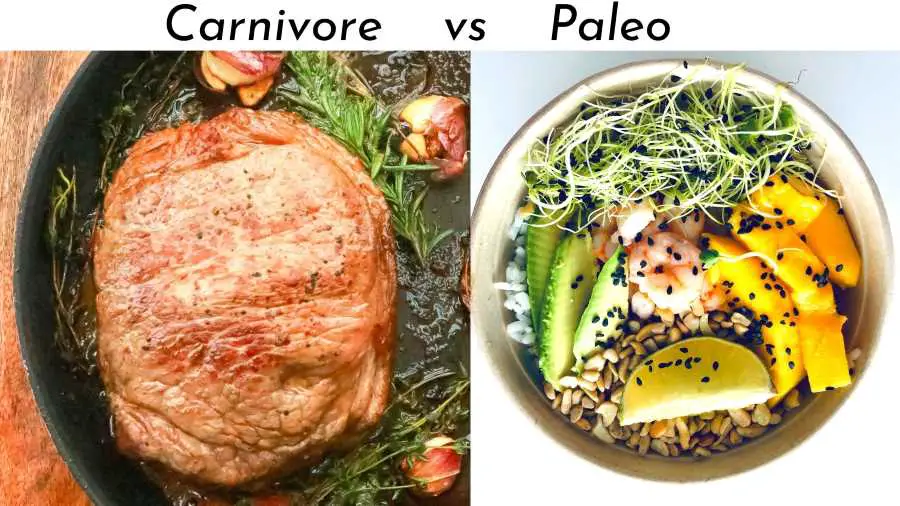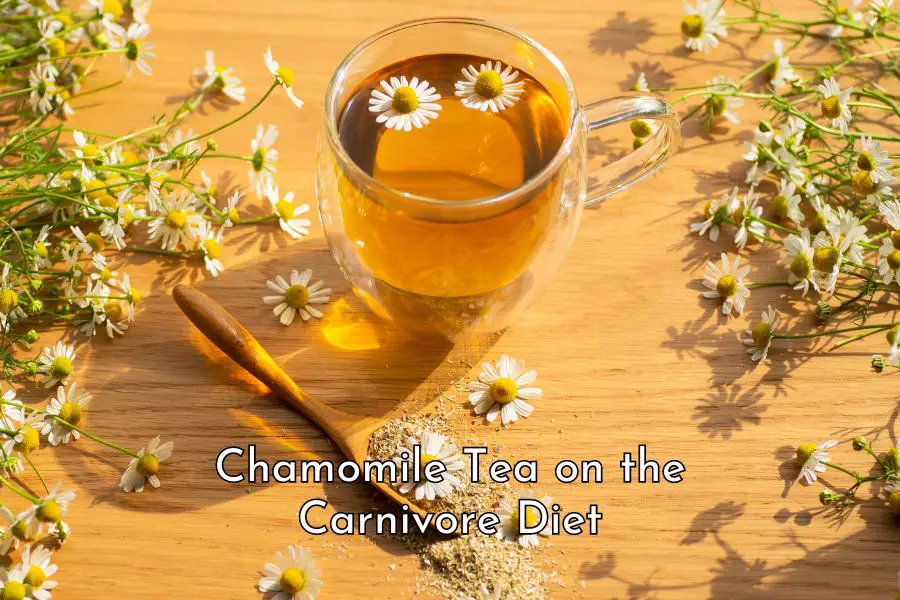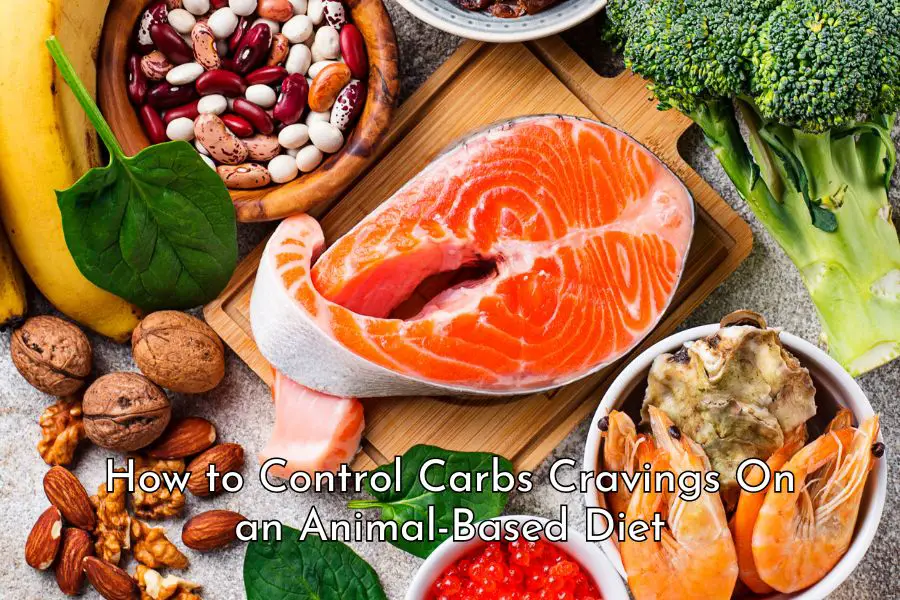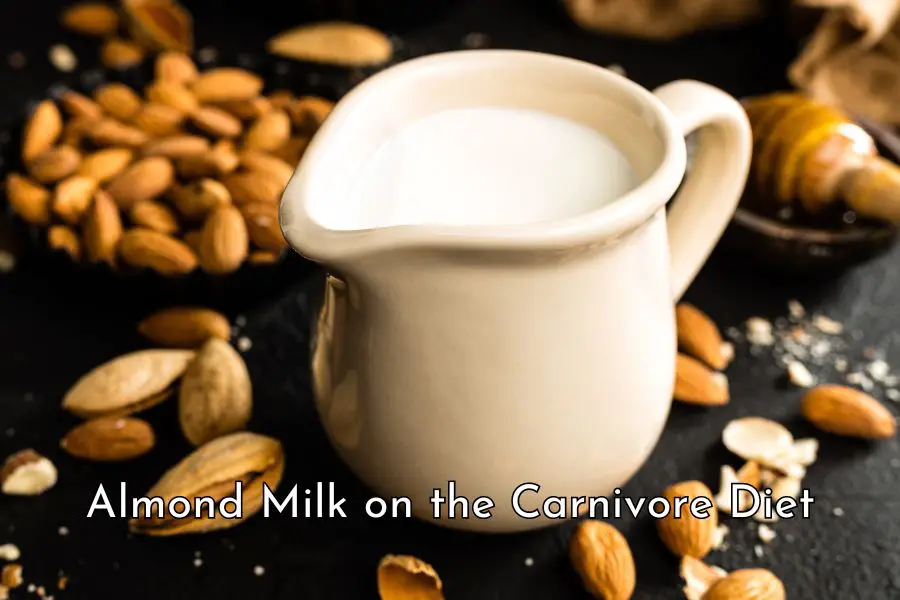Carnivore diet vs paleo diet: which one is healthier and which one you should be on? This post will compare the two diets and answer this question.
As the name implies, the modern paleo diet aims to mimic our ancestors’ diet during the paleolithic diet.
The idea is a great one and, if well executed, the modern paleo diet would have been the healthiest diet for humans.
However, the modern paleo diet is modeled after the 20th-century hunter-gatherer’s diet which has been found to be not representative of our ancestors’ diet.
The paleo diet advocates roughly 50% energy from meat and 50% energy from plant food, whereas recent research evidence indicates that our ancestors were likely hyper-carnivorous apex predators who dined almost exclusively on meat of large animals.
Although a much healthier diet than the standard American diet, the paleo diet still contains a high level of plant anti-nutrients due to a substantial intake of plant food.
Therefore, in my view, the carnivore diet is a healthier diet than the paleo diet because carnivore diet food is the most nutrient-dense, highly bioavailable and also free from plant toxins by definition.
The remainder of the post gives an overview of the two diets, their food lists, the origins of the diets and the logic behind these diets. It also goes into detail as to what goes wrong with the paleo diet and why the carnivore diet is considered a healthier one.
The carnivore diet
1. What is the carnivore diet?
A carnivore is an animal that feeds on other animals. Therefore, strictly speaking, by definition, someone on the carnivore diet will eat animal-sourced food only such as ruminants, pork, poultry, and seafood and drink water.
However, a broader version of the carnivore diet can include all foods that come from or are produced by an animal including ruminant meat (e.g. beef, lamb, goat, and bison), pork, poultry, seafood, eggs, dairy, and honey.
All plant food including grains, legumes, nuts, seeds, vegetable oils, seed oils, fruits, and vegetables are excluded from this diet.
2. What to eat on the carnivore diet?
On the carnivore diet, generally all you can eat are food from the animal kingdom, e.g. beef, lamb, goat, bison, pork, poultry, seafood, eggs, dairy, honey.
There is no official version of the carnivore diet with a list of foods that you can and can’t eat on this diet.
If you want to try out the carnivore diet, the main determinants of what you should eat on this diet are your health conditions, your goals and your personal preferences.
Some people do well with just muscle meat and water. For example, the Anderson family reportedly has been living on a diet of just ribeye steaks and water for the last 20 years, no salt, no seasonings, and no supplements. Mikhaila Peterson was on a diet of just beef, salt and water for a while and managed to reverse many chronic health conditions.
However, some advocate a nose-to-tail approach on this diet where one eats not just muscle meat but also makes use of every part of the animal including bones, skin and organs because they are considered the most nutrient-dense food. For example, liver is a rich source of protein, iron, zinc, riboflavin, niacin, vitamin A, folate, and vitamin B12; kidney is rich in protein, thiamin, riboflavin, iron, and a source of folate; and heart is a great source of vitamin B12, CoQ10 and many other essential vitamins and minerals.[1]
Some people do fine with a variety of animal-sourced food and even include a small amount of plant food while some people have no choice but to stick to just ruminant meat and organs due to intolerance.
You don’t need to count calories or maintain a certain macronutrient ratio on the carnivore diet. However, with a negligible amount of carbohydrates on this diet, you are likely to be in ketosis unless you purposely go for lean cuts only.
The macronutrient ratio on the carnivore diet is approximately:
- 0-5% of energy from carbohydrates
- 60-85% of energy from fat
- 15-40% of energy from protein.
3. The origin of the carnivore diet
The carnivore diet as it is known today originated from the zero-carb diet which has been around for over 20 years as an effective way to lose weight and resolve many chronic health conditions.
It shot to prominence in the last few years largely thanks to Dr. Shawn Baker, a US-based orthopedic surgeon.
Prior to the carnivore diet, Baker was on the ketogenic diet and, after experiencing many health benefits from it, became an advocate of this diet.
However, in 2016, he came across a group of people who had been eating only meat and thriving. Curious, Baker tried it out, loved it, and because he was active on social media, he began attracting attention from many people.
In 2017, Baker appeared on the Joe Rogan Experience podcast, one of the most influential and most-watched podcasts in the world, and this has helped with his popularity as well as that of the carnivore diet.
In 2018, Jordan Peterson, a well-known Canadian professor of psychology and clinical psychologist, also appeared on the Joe Rogan Experience podcast and talked about his remarkable experience with the carnivore diet.
Jordan Peterson said that his lifelong depression, anxiety, gastric reflux, inability to wake up in the mornings, psoriasis, gingivitis, floaters in his right eye, numbness on the sides of his legs, problems with mood regulation were all gone after a few months on the diet.
Jordan Peterson’s experience has inspired many people to try out the carnivore diet, including Dr. Paul Saladino who has now become another advocate of the carnivore diet.
Despite being labeled as a fad, extreme, restrictive, unbalanced, and even dangerous diet by dieticians and health professionals, the carnivore diet is on track to become one of the mainstream diets.
Although lacking in research evidence, thousands of people have tried out and stuck to the diet because they’ve experienced many health benefits from this way of eating.
Far from being unsafe, so many people have actually been thriving on this diet.
4. The logic behind the carnivore diet
The main reason for eating only animal-sourced food and avoiding all plant food on the carnivore diet is that animal-sourced food is the most nutrient-dense and bioavailable food that you can ever eat.
Animal-sourced food provides you with complete proteins, good fats and an abundance of all essential vitamins and minerals as well as unique beneficial compounds.
Animal-sourced food is also highly bioavailable. Due to the absence of anti-nutrients, your body can absorb nutrients from animal-sourced food much better than from plant-based food.
Plant food, although can contain beneficial nutrients, is also full of natural pesticides that are detrimental to human health.
Nature is all about the survival of the fittest. Every species that survives to this day has some form of self-defense mechanism.
Animals have teeth to bite, beaks to peck, legs to run, wings to fly, poison to kill, or ways to disguise.
Innocent-looking plants also have a sophisticated self-defense system to make themselves less palatable or even deadly to predators to maximize their chance of survival. Because they are stuck to the ground, to deter their predators, they produce toxins in their leaves, stems, flowers, fruits, seeds, and roots.
Some common plant toxins are lectins, gluten, saponins, tannins, phytic acid, goitrogens, and oxalate. These anti-nutrients when consumed in sufficient quantities can have an adverse effect on human health and symptoms include nausea, bloating, headaches, rashes, and nutritional deficiencies. More serious consequences include malabsorption, malnutrition, intestinal permeability, and autoimmune conditions. [1]
While we are all concerned about man-made pesticides in food, synthetic pesticide residues are found to be insignificant relative to natural pesticides.
It is estimated that Americans eat about 1.5 g of natural pesticides per person per day, which is about 10,000 times more than they eat of synthetic pesticide residues.[2]
Natural pesticides that are found to be rodent carcinogens are present in most of the fruits and vegetables that you can buy in the supermarket today.
Even though only a tiny proportion of the plant toxins in our diet have been tested so far, the 27 natural pesticides that are rodent carcinogens are present in the following foods: anise, apple, apricot, banana, basil, broccoli, brussels sprouts, cabbage, cantaloupe, caraway, carrot, cauliflower, celery, cherries, cinnamon, cloves, cocoa, coffee, collard greens, comfrey herb tea, currants, dill, eggplant, endive, fennel, grapefruit juice, grapes, guava, honey, honeydew melon, horseradish, kale, lentils, lettuce, mango, mushrooms, mustard, nutmeg, orange juice, parsley, parsnip, peach, pear, peas, black pepper, pineapple, plum, potato, radish, raspberries, rosemary, sesame seeds, tarragon, tea, tomato, and turnip.
Thus, it is probable that almost every fruit and vegetable in the supermarket contains natural plant pesticides that are rodent carcinogens. The levels of these 27 rodent carcinogens in the above plants are commonly thousands of times higher than the levels of synthetic pesticides.
Ames et al (1990)
Therefore, it makes perfect sense to many people to avoid plant food altogether and consume only animal-based food.
Why eat less optimal food if your goal is optimal health?
The paleo diet
1. What is the paleo diet?
The paleo diet is a diet that aims to mimic the way our ancestors ate during the paleolithic period which dates from around 2 million years ago to around 10,000 years ago.
Because it is impossible to reconstruct the exact diet of the paleolithic period, the modern-day paleo diet has been modeled following the typical diet of hunter-gatherer societies.
This diet typically includes food that had supposedly been eaten pre-agriculture such as meat, fish, fruits, nuts, seeds, tubers, and some other leafy vegetables. Processed food, sugar, grains, legumes, and dairy products are excluded.
2. What to eat on the paleo diet?
There are various versions of the paleo diet with slightly different paleo food lists.
The most authoritative site on the paleo diet is probably one owned by Dr. Loren Cordain who is widely regarded as the father of the modern paleo diet.
The site lists the following food that you are allowed to eat on the paleo diet:[3]
- Leafy vegetables
- Fresh fruits
- Root vegetables including sweet potatoes
- Nuts and seeds including their unsalted butters
- Seafood
- Grass-fed meat
- Free-range poultry and eggs
- Healthy oils (olive, walnut, flaxseed, macadamia, avocado, coconut)
- Fresh or dried herbs
- Water and herbal tea.
The website also lists the following food that should be excluded from the paleo diet:
- Grains, including oats, pasta and cereal
- Dairy products, including milk and yogurt
- Legumes including beans, soy and peanuts
- Potatoes, except sweet potatoes
- Processed food
- Refined vegetable oils
- Added salt and sugar.
The following items can be consumed sparingly on the paleo diet:
- Natural sweeteners, like honey, molasses or dates
- Coffee
- Beer and wine
- Almond flour, coconut flour, or other baking replacements.
Dr. Loren Cordain advocates an 85%:15% rule where you aim to eat paleo 85% of the time and non-paleo 15% of the time.
Similar to the carnivore diet, on the paleo diet, you are encouraged to not count calories or maintain a certain macronutrient ratio.
Due to the significant plant food intake, you are unlikely to be in ketosis on the paleo diet. The macronutrient ratio on the paleo diet is approximately:[4]
- 20-40% energy from carbohydrate
- 28-47% energy from fat
- 19-35% energy from protein.
3. The origin of the paleo diet
The paleo diet, also known as the caveman diet or the stone age diet, has been around since the 1970s.
It began with the work of Walter Voegtlin (1975) who proposed that an animal meat-fat diet is the only diet that best fits the physiological needs of a human body.
Eaton et al (1985) extended further the concept of a paleolithic diet and published a seminal paper on this topic which was followed by a book in 1989 titled “The Paleolithic Prescription: A Program of Diet & Exercise and a Design for Living”.
Dr. Loren Cordain, a professor of health and exercise science at Colorado State University, was the one who coined the term “paleo diet” and helped with its popularity with the publication of his book on this topic in 2002.
Today, the paleo diet is one of the most popular diets with an estimate of between 1 and 3 million Americans following this diet.
In 2013, paleo was the most searched term according to Google. However, it has lost its popularity somewhat lately with the rise of the ketogenic diet, intermittent fasting, and the carnivore diet.
4. The logic behind the paleo diet
The logic behind the paleo diet is that while environmental and living conditions changed rapidly during the last 10,000 years or so, our genetics hasn’t caught up and remained largely the same as that at the end of the paleolithic period and that the human body is more suited to the diet of our ancestors, the pre-agricultural diet. [5, 6, 7]
The discordance between our paleolithic genetics and today’s diet is arguably the main cause of many chronic diseases.
Accordingly, the paleo diet tries to fix this discordance by including only the food that our ancestors used to eat.
Due to the lack of information on what exactly our ancestors ate and the rapid changes in living conditions over the last 10,000 years or so, the diet of hunter-gatherer groups has been used as a proxy for our ancestors’ diet by the creators of the paleo diet.
As a result, as mentioned above, the paleo diet includes foods that are considered to have existed before the agricultural revolution such as fruits, leafy vegetables, tubers, fish, grass-fed meat, pasture-raised poultry and eggs, nuts, and some healthful oils and excludes all grains, dairy, and all processed foods.
5. Where the paleo diet goes wrong
(i) The modern-day paleo diet is a poor reconstruction of our ancestors’ diet using an inappropriate proxy
While it is a perfectly logical idea to mimic the way our ancestors used to eat, in my opinion, the execution of the concept is what goes wrong with the paleo diet.
The paleo diet is modeled after the 20th-century hunter-gatherer’s diet which is found to be not a representative of our ancestors’ diet throughout most of human evolution history.
In a recently published study, Ben-Dor et al (2021) find that the totality of evidence from human physiology and genetics, archeology, paleontology, and zoology points to the fact that humans were definitely not generalist omnivores as previously widely believed.[8]
Instead, they were hyper-carnivorous apex predators that ate mostly meat from large animals for 2 million years. Their diet was definitely not that of typical hunter-gatherer societies.[9]
As Dr. Ben-Dor and his team pointed out, the ecosystem in which our ancestors lived 2 million years ago is totally different from the one in which 20th-century hunter-gatherer societies lived. Our ancestors ate mostly meat whereas hunter-gatherer societies included a lot more plant food in their diet, given the extinction of many large mammals.
(ii) The modern-day paleo diet includes a lot of non-paleolithic plant food all year round
As pointed out above, our ancestors mostly dined on meat and plant food was unlikely to have had any significant role in their diet for millions of years.
The paleo diet, however, encourages you to eat an unlimited amount of fruits and vegetables all year round with a ratio of roughly 50% energy from animal food and 50% energy from plant food. Our ancestors, on the other hand, were likely to have eaten only a very small quantity of seasonal plant food for survival purposes.
Furthermore, most of the plant food available today (fruits, vegetables, nuts, seeds, tubers, and leafy vegetables) are also very different from the little plant food that our ancestors ate during lean times as a result of thousands of years of selectively breeding by farmers and genetic engineering in recent times.
Fruits are all bigger, juicier, a lot sweeter, and some are even seedless. Roots and tubers like carrots and sweet potatoes are also a lot bigger and sweeter.
These plant foods did not exist pre-agriculture and are definitely not what our ancestors used to eat.
(iii) The modern-day paleo diet might help better meet RDAs of various nutrients in theory but is also high in anti-nutrients
While the paleo diet is rich in essential nutrients and can easily meet the RDAs for various nutrients such as potassium, calcium, magnesium, folate and vitamin C in theory,[10] it is important to note that nutrients from plant sources come with anti-nutrients that interfere with their absorption. Nutrient intake can be very different from nutrient absorption in this case.
Some essential nutrients from animal-sourced foods may be low but, because they are well utilized by the human body, the risk of nutrient deficiency is very low.
For example, despite a very low magnesium content in animal-sourced food, in a study looking at 50 people on a high-fat meat-based diet, all but one had sufficient serum magnesium levels. Only one subject had a slightly lower than the normal range (0.74 mmol/l compared to the normal range of 0.75 to 1.06 mmol/l).[11]
In summary, the idea of a diet mimicking the ancestral diet is great but the poor execution results in a diet that is so far removed from our ancestors’ way of eating.
Carnivore vs Paleo: which diet is better?
Due to a very high percentage of plant food and hence a substantial intake of plant anti-nutrients on the paleo diet, in my view, the carnivore diet is better than the paleo diet.
For the paleo diet to actually represent our ancestors’ way of eating for millions of years before the advent of agriculture, animal-sourced food, especially those from large ruminants, should be the main energy source. Plant food should be eaten only occasionally, in very small quantities, and with seasons.
Our ancestors might have eaten some seasonal plant food such as berries, tubers, nuts, and seeds to survive from time to time but it was unlikely to have a major role in their diet.
As mentioned above, all evidence from large brain size, genetic and metabolic adaptation to a high-fat diet, extreme stomach acidity, gut morphology to mastication all points to the fact that our ancestors were dining on mostly meat.[12]
For healthy individuals who are free from chronic conditions, a real paleolithic diet that comprises mostly animal-based food and a very small quantity of seasonal plant food can be a good option.
This diet is easier to follow compared to the carnivore diet, more socially acceptable, and easier to meet all nutritional needs.
In addition, it also helps you maintain metabolic flexibility and provides a small amount of plant anti-nutrients as a form of acute stressors that can help make your body stronger and more resilient. If for whatever reason you are faced with a situation where meat is scarce, you want to be able to survive on plant food temporarily without any issues rather than falling ill after eating just a few berries or a few nuts.
People with health issues such as autoimmune conditions may have no choice but to follow the most strict version of the carnivore diet of only meat and organ meat until their health problems are resolved.
In summary, your health conditions and personal preferences should dictate which diet is the best for you.
If you find this post helpful, please consider sharing this post and my site with your family, friends, and followers. That would be much appreciated. Please also check out my library of articles on the carnivore diet here which is updated regularly.
Disclaimer: The information in this post is for reference purposes only and not intended to constitute or replace professional medical advice. Please consult a qualified medical professional before making any changes to your diet or lifestyle.





